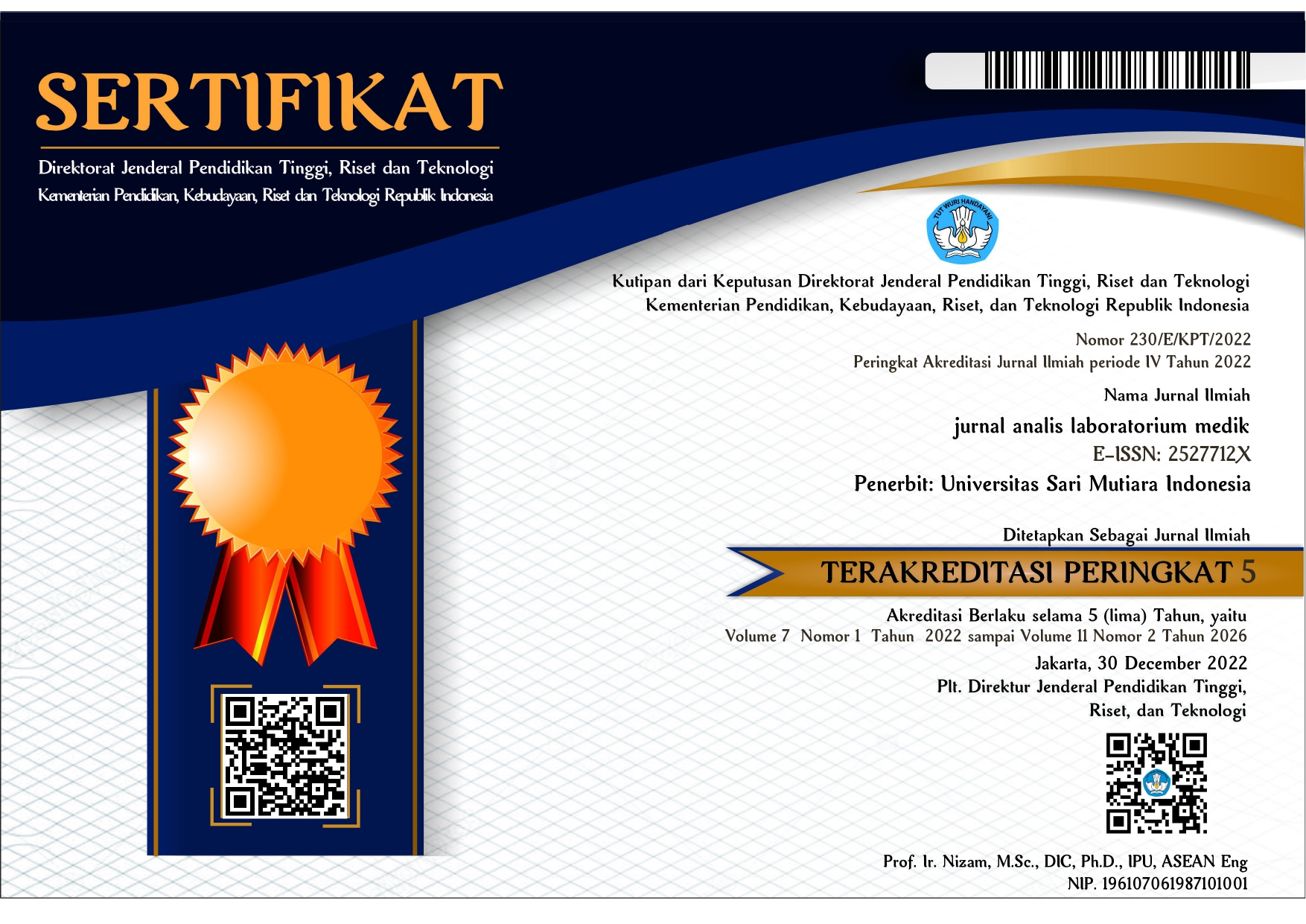CHOLESTEROL LEVELS BEFORE AND AFTER CONSUMING SAUSAGE
DOI:
https://doi.org/10.51544/jalm.v7i1.2822Keywords:
Cholesterol Levels, SausageAbstract
Cholesterol is a component of fat forming yellow and in the form of wax which is produced by the liver. One of the foods that can increase cholesterol levels is meat sausage. These food ingredients, if consumed in excess amounts, will increase fat levels in the body, which in turn will increase total cholesterol levels in the blood (hypercholesterolemia). In this millennial era, many foods are produced fast using raw materials from processed meat, one of which is sausage. Sausage is one of the foods that are high in fat, so there will be an increase in fat levels in the body when a person consumes 50 grams of sausage (half a portion). Methods: This research uses analytic / inferential research, namely pre-experiment. There were 20 subjects used.The average (mean) blood cholesterol level before consuming sausage was 203.51 mg / dL and the mean (mean) blood cholesterol level after consuming sausage was 207.67 mg / dL. Furthermore, the results obtained after statistical testing using the paired T-Test, namely p value = 0.056, meaning that there was no significant difference in cholesterol levels before and 2 hours after consuming sausages.In this study it can be concluded that there is no significant difference in cholesterol levels before and 2 hours after consuming 75 grams of sausage (1 serving).
Downloads
References
Badan Pusat Statistik. (2018). Survei Demografi dan Kesehatan 2017. Riset Kesehatan Dasar 2018.
Bagiastra, I. N., & Yuliartini Griadhi, N. M. A. (2019). MODEL PENGATURAN ANTI OBESITAS DALAM RANGKA PENGUATAN SERTA PENINGKATAN DERAJAT KESEHATAN MASYARAKAT DI INDONESIA. Jurnal Ilmu Sosial Dan Humaniora. https://doi.org/10.23887/jish-undiksha.v8i2.22377
Davison, K. M., & Kaplan, B. J. (2012). Food intake and blood cholesterol levels of community-based adults with mood disorders. BMC Psychiatry. https://doi.org/10.1186/1471-244X-12-10
Fitri, R. R. (2019). HUBUNGAN ASUPAN LEMAK, KOLESTEROL DAN STATUS GIZI DENGAN KADAR KOLESTEROL PASIEN HIPERKOLESTEROLEMIA RAWAT JALAN DI RSUD Dr. MOEWARDI SURAKARTA. Hubungan Asupan Lemak, Kolesterol Dan Status Gizi Dengan Kadar Kolesterol Pasien Hiperkolesterolemia Rawat Jalan Di RSUD Dr. Moewardi Surakarta.
Kementrian Kesehatan RI. (2018). Riset Kesehatan Dasar Indonesia. Badan Penelitian Dan Pengembangan Kesehatan.
NIH. (2020). High Blood Pressure | National Heart, Lung, and Blood Institute (NHLBI).
OBESITAS SENTRAL DAN KADAR KOLESTEROL DARAH TOTAL. (2013). KESMAS - Jurnal Kesehatan Masyarakat. https://doi.org/10.15294/kemas.v9i1.2828
RI, K. K. (2014). Peraturan Menteri Kesehatan Republik Indonesia Nomor 41 Tahun 2014 Tentang Pedoman Gizi Seimbang. MENTERI KESEHATAN REPUBLIK INDONESIA.
Rusnoto, R., & Firman Setyono, D. (2018). HUBUNGAN HIPERKOLESTEROLEMIA, OBESITAS DAN RIWAYAT HIPERTENSI KELUARGA DENGAN KEJADIAN HIPERTENSI DI DESA MEGAWON KUDUS. Jurnal Ilmu Keperawatan Dan Kebidanan. https://doi.org/10.26751/jikk.v9i1.408
Sari, Y. D., Prihartini, S., & Brantas, K. (2014). Asupan serat makanan dan kadar kolesterol-LDL… (Sari YD; dkk). Penelitian Gizi Dan Makanan.
Shafira, N. I., Ngaisyah, R. D., & Yuningrum, H. (2020). Hubungan konsumsi serat dan indeks massa tubuh dengan hiperkolesterolemia di pos pembinaan terpadu (posbindu) untuk penyakit tidak menular Kabupaten Kulon Progo Yogyakarta. Ilmu Gizi Indonesia, 4(1), 51. https://doi.org/10.35842/ilgi.v4i1.160
Yoeantafara, A., & Martini, S. (2017). PENGARUH POLA MAKAN TERHADAP KADAR KOLESTEROL TOTAL. Media Kesehatan Masyarakat Indonesia. https://doi.org/10.30597/mkmi.v13i4.213
Downloads
Published
How to Cite
Issue
Section
License
Syarat yang harus dipenuhi oleh Penulis sebagai berikut:
Â
- Penulis menyimpan hak cipta dan memberikan jurnal hak penerbitan pertama naskah secara simultan dengan lisensi di bawah Creative Commons Attribution License yang mengizinkan orang lain untuk berbagi pekerjaan dengan sebuah pernyataan kepenulisan pekerjaan dan penerbitan awal di jurnal ini.
- Penulis bisa memasukkan ke dalam penyusunan kontraktual tambahan terpisah untuk distribusi non ekslusif versi kaya terbitan jurnal (contoh: mempostingnya ke repositori institusional atau menerbitkannya dalam sebuah buku), dengan pengakuan penerbitan awalnya di jurnal ini.
- Penulis diizinkan dan didorong untuk mem-posting karya mereka online (contoh: di repositori institusional atau di website mereka) sebelum dan selama proses penyerahan, karena dapat mengarahkan ke pertukaran produktif, seperti halnya sitiran yang lebih awal dan lebih hebat dari karya yang diterbitkan. (Lihat Efek Akses Terbuka).





 This work is licensed under a
This work is licensed under a 




